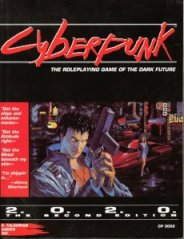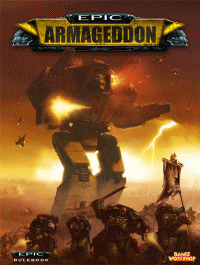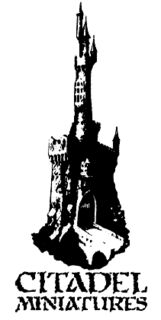Related Research Articles

Warhammer 40,000 is a miniature wargame produced by Games Workshop. It is the most popular miniature wargame in the world, and is particularly popular in the United Kingdom. The first edition of the rulebook was published in September 1987, and the ninth and current edition was released in July 2020.

Games Workshop Group is a British manufacturer of miniature wargames, based in Nottingham, England. Its best-known products are Warhammer Age of Sigmar and Warhammer 40,000.

Cyberpunk is a tabletop role-playing game in the dystopian science fiction genre, written by Mike Pondsmith and first published by R. Talsorian Games in 1988. It is typically referred to by its second or fourth edition names, Cyberpunk 2020 and Cyberpunk Red, in order to distinguish it from the cyberpunk genre after which it is named.

Icehouse pieces, or Icehouse Pyramids, Treehouse pieces, Treehouse Pyramids and officially Looney Pyramids, are nestable and stackable pyramid-shaped gaming pieces and a game system. The game system was invented by Andrew Looney and John Cooper in 1987, originally for use in the game of Icehouse.

Miniature wargaming is a form of wargaming in which military units are represented by miniature physical models on a model battlefield. The use of physical models to represent military units is in contrast to other tabletop wargames that use abstract pieces such as counters or blocks, or computer wargames which use virtual models. The primary benefit of using models is aesthetics, though in certain wargames the size and shape of the models can have practical consequences on how the match plays out.

Epic is a tabletop wargame set in the fictional Warhammer 40,000 universe. Whereas Warhammer 40,000 involves small battles between forces of a few squads of troops and two or three vehicles, Epic features battles between armies consisting of dozens of tanks and hundreds of soldiers. Due to the comparatively larger size of the battles, Epic miniatures are smaller than those in Warhammer 40,000, with a typical human being represented with a 6mm high figure, as opposed to the 28mm minis used in Warhammer 40,000. Since being first released in 1988 as Adeptus Titanicus, it has gone through various editions with varying names.

Warhammer is a tabletop miniature wargame with a medieval fantasy theme. The game was created by Bryan Ansell, Richard Halliwell, and Rick Priestley; it was published by the Games Workshop company.

Warmaster is a ruleset for tabletop wargames written by Rick Priestley, published by Specialist Games, and set in the Warhammer Fantasy setting. It is different from Warhammer Fantasy Battles in both appearance and gameplay. It is intended for 10 –12 mm miniatures. Basic troops are based on stands, of which typically three make a unit. Generals, Heroes and Wizards are mounted individually or with their retinue.
Inquisitor was a tabletop miniatures game based in Games Workshop's Warhammer 40,000 universe. Whereas the main line of Warhammer 40K games is based on squad based tactical warfare, Inquisitor focused on a small group of player characters akin to many role-playing games. Inquisitor miniatures are no longer produced by Games Workshop but, whilst they were, the game had its own website and 54 mm scale models were available as "Specialist Games" from the Games Workshop catalogue.

Citadel Miniatures Limited is a company which produces metal, resin and plastic miniature figures for tabletop wargames such as Warhammer Fantasy Battle and Warhammer 40,000.

Battlesystem is a tabletop miniature wargame designed as a supplement for use with the Dungeons & Dragons role-playing game. The original Battlesystem was printed as a boxed set in 1985 for use with the first edition AD&D rules. For the second edition of AD&D, a new version of Battesystem was printed as a softcover book in 1989.
Imperial Commander is a 15mm science fiction war game, based on the range of metal Laserburn miniatures available from Tabletop Games. Written by Richard Halliwell and Bryan Ansell in 1981, the game still has a small but enthusiastic following. Battles take place between an oppressive, galaxy spanning "Imperium" and the religious, fanatic "Red Redemption". Players take in turns to move, fight and command armies of between twenty and fifty miniature figures each, and following the rules, tabletop games lasting a few hours are played. This type of war game is played on a tabletop with miniature figures, vehicles and scenery. Two or more players are required. An updated version of this game, called Imperial Commander 2 was in development; however, it was never published because of copyright issues.
Bryan Ansell is a British role-playing and war game designer. In 1985, he became managing director of Games Workshop, and bought Games Workshop from Steve Jackson and Ian Livingstone.

Naval wargaming is a branch of the wider hobby of miniature wargaming. Generally less popular than wargames set on land, naval wargaming nevertheless enjoys a degree of support around the world. Both historical and fantasy rulesets are available.
Phil Barker is one of the major figures in the development of the modern hobby of tabletop wargaming, particularly that of ancient warfare, and is a co-founder of the Wargames Research Group.

Numenera is a science fantasy tabletop role-playing game set in the far distant future, written by Monte Cook, published in 2013.
Deadzone is a 28 to 32 mm scale science-fiction skirmish tabletop wargame created by Mantic Games.

Martial Metals was a company that produced miniature figures in the 1970s and 1980s for science-fiction tabletop games.
Laserburn is a line of miniatures published in 1982 by Tabletop Games.
Richard Halliwell was a British game designer who worked at Games Workshop (GW) during their seminal period in the 1980s, creating many of the games that would become central to GW's success.
References
- ↑ "Laserburn 15mm Science Fiction" . Retrieved 13 November 2015.
- ↑ Ansell, Brian (August 1980). Laserburn: Sci. Fi. Combat Rules. Tabletop Games.
- ↑ "Gaming in the Laserburn universe" . Retrieved 13 November 2015.